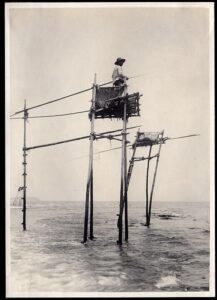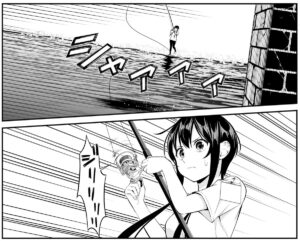Fishing for River Prawn
East Asian river prawn (Macrobrachium nipponense) is a popular target in Japan, among the expert fishermans. Despite the first impression of this 7 cm prawn, it makes a nice game on a thin and short whip telescopic rod.
In this article, we will see how it is caught and what makes it interesting, first. Secondly, the details of the species are shown.
Fishing for the river prawn
It is very simple float fishing. You can see it from the image of the rig below.
Whip rod of 1 to 1.5 m, with round float on the 0.6 to 0.8 gou main line. It has the split shot sinker with the swivel of a quick leader release and 0.4 gou leader and a hook. In some cases, fishermans are using the several smaller round float to eliminate the buoyancy, to present their bait more naturally.
There are special shrimp fishing hooks.
The mouth of the prawn is very small and the hook and the bait are very small.
The process of fishing is also very simple. Place the hooked bait near the place you think the prawn is hiding, and wait for the action.
One exciting thing is that it is not easy to let it bring the hooked bait to the mouth and get it hooked. Fish eat or gulp the bait with sucking the bait with water, but prawns do not do so. They pinch the bait and draw it with the craw, then, in most cases, they bring it back to their home to start eating or to bring the bait to its mouth.
Naturally, you cannot strike at the first movement of the float. You have to wait until the proper moment that it starts eating.
In the video below (of a YouTuber TsuriHack), a man is trying to catch the one he can see in the water. You can see that even when some movements of floats are starting, he does not raise his rod but waits for a while.
After it is hooked, the prawns backward movement with their strong tails gives fishermans a nice pleasure to play with fish, or prawn.
Species and distribution
The most prominent character of this species of Macrobrachium Genus is its long pair of legs with tiny craw. It is the second pair of pereiopods (leg part of shrimp or prawn.) Japanese see these legs as arms and we call it Tenaga-ebi, which literally means long armed shrimp.
This species is distributed from the tropical to the temperate zone. There are many species of this genus. While the species in the tropical climate zone tend to be bigger and some grow up to 20 cm of body size, the main 3 species in Japan’s Honshu island have about 5 to 10 cm.
It dwells in the lower parts of the river or the river mouth, in brackish water. It prefers the nutrition rich water to the clear water, such as the streams in the mountains. It is carnivorous and feeds on the water insects, small fish, dead fish and worms such as sludge worms.
It is more active during the night, to stay hiding under the rocks or holes during the day time. This nocturnal character makes it easier to come out from their hiding places on cloudy day time. It is said for each individual to have a territory and the owner attacks the invaders of it.
The females of this long armed prawn bear eggs between May and September, peaking in the summer. The females hold the born eggs, of about 1 mm size totalling 1000 to 2000 pieces, under their belly until hatching.
The hatched prawn, larva, goes down to the sea or the river mouth. And it grows to 5 mm length baby prawn. As it becomes this size, it goes up the river and starts living in freshwater. It lives up to 3 years, growing up to 20 cm in some rare cases in Honshu Island.
Note; Prawn fishing in Taiwan
Some of you remember shrimp fishing in Taiwan, shrimping, when you hear shrimp or prawn fishing in Asia. The Taiwanese’s favorite shrimp is different from this Japanese river prawn. Taiwan one is Pacific white shrimp (Litopenaeus vannamei) or Kuruma shrimp (Marsupenaeus japonicus.) Their shrimps do not have long arms like the Japanese fishing target shrimp. Probably the fun part of fishing may be common for these fishing styles.
The final bit of this fishing is attracting Japanese anglers. This prawn is very tasty.
As you know, fishing in Japan is related to eating. It makes this activity so rich and deep in connection with our lives.

